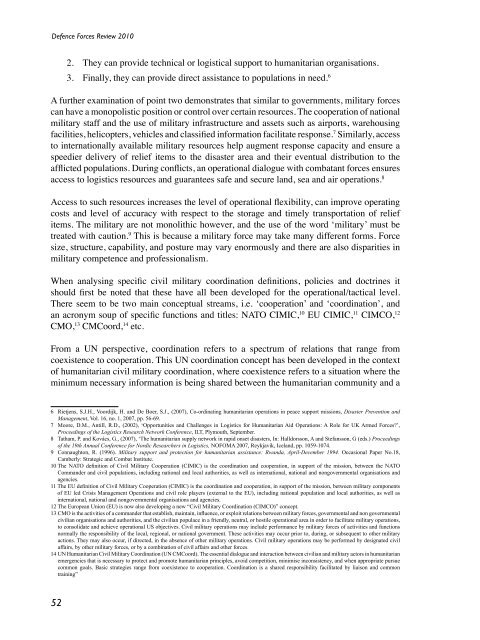Defence Forces Review 2010
Defence Forces Review 2010
Defence Forces Review 2010
Create successful ePaper yourself
Turn your PDF publications into a flip-book with our unique Google optimized e-Paper software.
<strong>Defence</strong> <strong>Forces</strong> <strong>Review</strong> <strong>2010</strong>2. They can provide technical or logistical support to humanitarian organisations.3. Finally, they can provide direct assistance to populations in need. 6A further examination of point two demonstrates that similar to governments, military forcescan have a monopolistic position or control over certain resources. The cooperation of nationalmilitary staff and the use of military infrastructure and assets such as airports, warehousingfacilities, helicopters, vehicles and classified information facilitate response. 7 Similarly, accessto internationally available military resources help augment response capacity and ensure aspeedier delivery of relief items to the disaster area and their eventual distribution to theafflicted populations. During conflicts, an operational dialogue with combatant forces ensuresaccess to logistics resources and guarantees safe and secure land, sea and air operations. 8Access to such resources increases the level of operational flexibility, can improve operatingcosts and level of accuracy with respect to the storage and timely transportation of reliefitems. The military are not monolithic however, and the use of the word ‘military’ must betreated with caution. 9 This is because a military force may take many different forms. <strong>Forces</strong>ize, structure, capability, and posture may vary enormously and there are also disparities inmilitary competence and professionalism.When analysing specific civil military coordination definitions, policies and doctrines itshould first be noted that these have all been developed for the operational/tactical level.There seem to be two main conceptual streams, i.e. ‘cooperation’ and ‘coordination’, andan acronym soup of specific functions and titles: NATO CIMIC, 10 EU CIMIC, 11 CIMCO, 12CMO, 13 CMCoord, 14 etc.From a UN perspective, coordination refers to a spectrum of relations that range fromcoexistence to cooperation. This UN coordination concept has been developed in the contextof humanitarian civil military coordination, where coexistence refers to a situation where theminimum necessary information is being shared between the humanitarian community and a6 Rietjens, S.J.H., Voordijk, H. and De Boer, S.J., (2007), Co-ordinating humanitarian operations in peace support missions, Disaster Prevention andManagement, Vol. 16, no. 1, 2007, pp. 56-69.7 Moore, D.M., Antill, R.D., (2002), ‘Opportunities and Challenges in Logistics for Humanitarian Aid Operations: A Role for UK Armed <strong>Forces</strong>?’,Proceedings of the Logistics Research Network Conference, ILT, Plymouth, September.8 Tatham, P. and Kovács, G., (2007), ‘The humanitarian supply network in rapid onset disasters, In: Halldorsson, A and Stefansson, G (eds.) Proceedingsof the 19th Annual Conference for Nordic Researchers in Logistics, NOFOMA 2007, Reykjavik, Iceland, pp. 1059-1074.9 Connaughton, R. (1996). Military support and protection for humanitarian assistance: Rwanda, April-December 1994. Occasional Paper No.18,Camberly: Strategic and Combat Institute.10 The NATO definition of Civil Military Cooperation (CIMIC) is the coordination and cooperation, in support of the mission, between the NATOCommander and civil populations, including national and local authorities, as well as international, national and nongovernmental organisations andagencies.11 The EU definition of Civil Military Cooperation (CIMIC) is the coordination and cooperation, in support of the mission, between military componentsof EU led Crisis Management Operations and civil role players (external to the EU), including national population and local authorities, as well asinternational, national and nongovernmental organisations and agencies.12 The European Union (EU) is now also developing a new “Civil Military Coordination (CIMCO)” concept.13 CMO is the activities of a commander that establish, maintain, influence, or exploit relations between military forces, governmental and non governmentalcivilian organisations and authorities, and the civilian populace in a friendly, neutral, or hostile operational area in order to facilitate military operations,to consolidate and achieve operational US objectives. Civil military operations may include performance by military forces of activities and functionsnormally the responsibility of the local, regional, or national government. These activities may occur prior to, during, or subsequent to other militaryactions. They may also occur, if directed, in the absence of other military operations. Civil military operations may be performed by designated civilaffairs, by other military forces, or by a combination of civil affairs and other forces.14 UN Humanitarian Civil Military Coordination (UN CMCoord). The essential dialogue and interaction between civilian and military actors in humanitarianemergencies that is necessary to protect and promote humanitarian principles, avoid competition, minimise inconsistency, and when appropriate pursuecommon goals. Basic strategies range from coexistence to cooperation. Coordination is a shared responsibility facilitated by liaison and commontraining”52
















